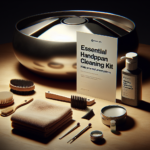<!DOCTYPE html>
<html lang="en">
<head>
<meta charset="UTF-8">
<meta name="viewport" content="width=device-width, initial-scale=1.0">
<title>Ensuring Long-Term Stability in Handpan Tuning: Best Practices</title>
</head>
<body>
<h1>Ensuring Long-Term Stability in Handpan Tuning: Best Practices</h1>
<p>The handpan, with its ethereal and hypnotic tones, has quickly amassed a dedicated following among musicians and enthusiasts alike. Ensuring the stability of its tuning over time is paramount to maintaining its unique sound and longevity. This article addresses best practices to achieve this goal, focusing on tuning techniques, material selection, environment considerations, maintenance, and playing habits. By adhering to these guidelines, you can enjoy consistent and stable tones from your handpan for years to come.</p>
<h2>Tuning Techniques</h2>
<p>The handpan's construction and tuning are intricate processes requiring precision and expertise. Here are some essential tuning techniques:</p>
<ul>
<li><strong>Accurate Placement of Notes:</strong> Each note requires precise placement and tuning to interact harmoniously with others. Experienced tuners use sophisticated electronic devices to ensure accurate pitch and frequency.</li>
<li><strong>Material Shaping:</strong> The metal used in handpans must be shaped and tuned while accounting for its unique resonant properties. The shaping process involves careful hammering, which needs to be performed by a skilled artisan.</li>
<li><strong>Frequency Matching:</strong> Tuners often use various methods such as electronic tuners, spectroscopes, and tuning forks to match frequencies accurately. Ensuring overtones match the primary note helps in creating a rich and resonant sound.</li>
</ul>
<h2>Material Selection</h2>
<p>The choice of material for a handpan significantly impacts its longevity and tuning stability. Here are some considerations for selecting the appropriate material:</p>
<ul>
<li><strong>Steel Quality:</strong> High-quality steel, like nitrided or stainless steel, is preferred due to its resistance to corrosion and structural rigidity. Poor quality steel can lead to detuning and reduced durability.</li>
<li><strong>Nitriding Process:</strong> This process involves hardening the steel surface through nitrogen infusion, which increases corrosion resistance and surface hardness. A well-nitrided handpan does not rust easily and retains tuning better.</li>
<li><strong>Thickness of the Material:</strong> A balanced thickness allows enough flexibility for proper tuning without being too fragile. Handpans that are too thin may detune quickly, while those that are too thick may be challenging to tune accurately.</li>
</ul>
<h2>Environment Considerations</h2>
<p>External conditions play a critical role in maintaining the stability of a handpan's tuning. Various environmental factors must be monitored and controlled:</p>
<ul>
<li><strong>Humidity Levels:</strong> Excessive humidity can lead to rust and corrosion, especially if your handpan is not made of stainless steel. Keeping the instrument in a humidity-controlled environment is crucial.</ li>
<li><strong>Temperature Fluctuations:</strong> Extreme temperatures and sudden fluctuations can affect the material properties and tuning. It's best to store the handpan in a consistent temperature setting.</li>
<li><strong>Proper Storage:</strong> When not in use, store the handpan in a padded, moisture-proof case. Avoid placing it directly on hard surfaces, which can amplify vibrations and lead to detuning or damage.</li>
</ul>
<h2>Maintenance</h2>
<p>Regular maintenance is essential to keep your handpan in optimum condition. Here are some best practices:</p>
<ul>
<li><strong>Cleaning:</strong> Use a soft, dry cloth to wipe off fingerprints, dirt, and oils after playing. For deeper cleaning, a slightly damp cloth with mild soap can be used, followed by thorough drying.</li>
<li><strong>Oiling:</strong> Occasionally oiling your handpan with food-grade oils can help prevent rust and maintain a polished look. Avoid over-oiling, as excessive oil can build up and attract dirt.</li>
<li><strong>Inspection:</strong> Regularly inspect your handpan for any signs of detuning, rust, or other damage. Early detection can prevent more severe issues and allow for timely repairs.</li>
</ul>
<h2>Playing Habits</h2>
<p>How you play your handpan can also affect its long-term tuning stability. Consider these tips:</p>
<ul>
<li><strong>Avoid Excessive Force:</strong> Striking the notes too hard can lead to detuning and damage. Use gentle, controlled strikes to produce the desired sound without exerting excessive force.</li>
<li><strong>Hands Over Mallets:</strong> Playing with your hands not only provides better control over the sound but also reduces the risk of damage compared to using hard mallets.</li>
<li><strong>Varied Techniques:</strong> Use a variety of techniques (e.g., different hand shapes and positions) to distribute the impact evenly across the instrument, preventing localized wear and detuning.</li>
</ul>
<h2>Conclusion</h2>
<p>Ensuring the long-term stability of your handpan's tuning requires a holistic approach encompassing proper tuning techniques, high-quality materials, controlled environmental conditions, regular maintenance, and mindful playing habits. By following these best practices, you can preserve the beautiful sounds of your handpan for years to come, allowing the instrument to continue providing its mesmerizing and meditative music.</p>
<h2>FAQs</h2>
<h3>1. How often should I tune my handpan?</h3>
<p>The frequency of tuning depends on usage and environmental conditions. Generally, it's recommended to get your handpan professionally tuned at least once a year, or more frequently if you notice any detuning.</p>
<h3>2. Can I tune my handpan myself?</h3>
<p>Tuning a handpan is a specialized skill that requires experience and precision. Attempting to tune it yourself without proper training can cause more harm than good. It's best left to professional tuners.</h3>
<h3>3. What should I do if my handpan gets wet?</h3>
<p>If your handpan gets wet, dry it immediately with a soft cloth. Ensure that no water is trapped in the crevices. If needed, use a small amount of oil post-drying to prevent rust.</h3>
<h3>4. Is it safe to travel with my handpan?</h3>
<p>Yes, but it's important to use a well-padded case designed for handpans to protect it from physical knocks and environmental changes. Avoid leaving it in hot cars or exposed to extreme conditions during travel.</h3>
<h3>5. Can temperature changes affect my handpan?</h3>
<p>Yes, extreme temperature fluctuations can alter the metal's properties and affect tuning. Keep your handpan in a stable, moderate environment away from direct sunlight or cold drafts.</h3>
</body>
</html>Ensuring Long-Term Stability in Handpan Tuning: Best Practices

Leave a comment




